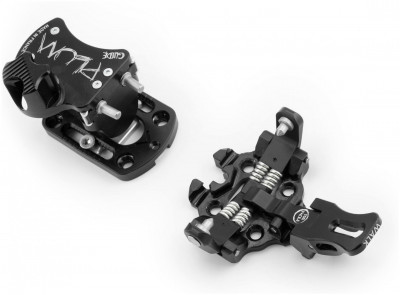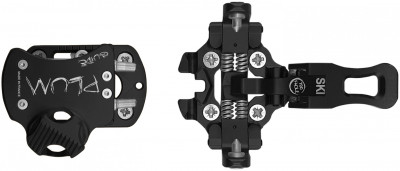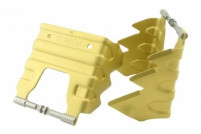Plum Guide 12 Binding
Take a proven design, add higher release values and more adjustability, and you get the Plum Guide binding. Crafted in France with extremely accurate CNC machines, the binding echoes the classic TLT Speed that has proven itself reliable for more than a decade. However by using aerospace grade materials, Plum was able to increase the overall strength and dial up the max release value to 12. And with 30mm of boot sole length adjustability, the Guide can adapt to roughly 4 full sizes, making for very flexible mounts. If you're looking for a sturdy, lightweight binding with simple operation, Plum may have found the answer.
- Machined with aerospace grade aluminum, steel, and polyvinyl to achieve tangible strength and rigidity.
- Lateral and vertical (forward) release values can be adjusted between a range of 5.5 and 12 (similar to DIN values).
- Two riser heights (in addtion to flat) can be engaged by rotating the heel piece with either hand or a pole.
- Heel adjusts forward and backward within a 30mm range so the same mount can accommodate 4-5 full boot sizes.
- Front lever flips between fully-locked uphill and releasable ski modes, with a handy inscription so you know which mode you're in.
- Toe piece features a ski crampon receptor so you can get extra traction while skinning snow ice.
- Same mounting pattern as the Dynafit Speed, Comfort, and Vertical series so you may be able to use existing drill holes.
Update 17/18: Plum added a new orange color. Brake widths changed to 85mm, 95mm, 105mm, 115mm, or 135mm. The brakes have a locking mechanism designed to prevent deploying when skinning uphill. Also Plum is now making ski crampons which can be dropped into the top of the receptor instead of slid in from the side like the others. Binding remains solid.
Update 19/20: Plum is now offering this solid binding covered in a slick coat of black paint...err, anodization.
Update 20/21: Plum machined a little more off the toe piece to shave 10g and refined the heel a bit.
| Specifications | |
|
Weight |
341g |
| Weight (pair) | 682g |
|
Boot |
Tech |
|
Brakes |
Optional leashes |
|
BSL |
30mm |
|
Riser |
2 + flat |
|
Vertical |
5.5-12 |
|
Lateral |
5.5-12 |
|
Crampon |
Yes |
| Specs Verified | Yes |
| Design | |
|
|
Aluminum, steel, polyvinyl |
| Skimo Co Says | |
| Usage | Everyday touring |
| Notes | Classic rotational heel piece with release values up to 12 |
| Bottom Line | Impressive strength for the weight |
| Compare to other Lean Bindings | |
Related Products
Questions & Reviews
Despite my experience, there are reports of toe wing failures, although they seem to have been mostly fixed by my generation of bindings. My only personal annoyance with the bindings is that the heel tower has a slight edge to it, and it is possible to have your pole jerked out of your hand if it gets stuck in there when you're rotating the heel.
All in all, a killer binding, with what I would argue is one of the best heels available. My dream is to one day frankenbinding these with Radical toes but for now they remain my go to touring binding.
Background on product familiarity: I have about 118,000’ earned vertical plus a single lift-served lap on the original generation from Fall 2010. Similar bindings I’ve previously used include various traditional Dynafits (IV/Tech/Classic/Speed, Comfort, Vertical ST) and now mainly various race and near-race models (from both Dynafit and its competitors).
First, the first impressions out of the box: If you’re familiar with the core Dynafit design dating back to the early 1990s and then continuing along until only a few years ago as the Speed model, then this will look like a refined CNC’ed version rendered in irresistibly slick aluminum and delrin.
Some of the highlights include a one-piece toe without a separate plastic mounting shim (although Dynafit has since emulated that on the Speed Radical), and an integrated heel unit top plate and heel elevator with multiple insertion positions for a ski pole tip. The heel track boasts the longest fore-aft adjustment range at 30mm of any non-demo/rental model, although the two hold-down screws takes a bit more time to adjust than a more typical worm drive.
The heel > toe “delta” is typically high for touring bindings, since the heel pins have to rest above a large spring to control lateral release, and the toe has no other reason to be anything but directly on top of the ski’s topskin. (For more on that subject, see Skimo’s “Binding Pin Heights” article here.) However, the Guide toe is especially easy to shim with LDPE since its footprint is so small (and the longer screws don’t need to be very long, since the originals are extremely short). Plus the optional add-on brake doubles as a toe shim.
The heel pins are the typical ~12mm length yet with a shorter 4mm gap, for more penetration into the boot heel interface, and hence in theory able to tolerate more of a ski’s extreme recambering before prereleasing. (For more on that subject, see Skimo’s “Mind the Heel Gap” article.)
The middle and higher heel elevator positions are fairly typical for touring bindings (i.e., the middle a bit too high for optimal skintracks, and the higher only for desperation moves, respectively). A truly flat position is also available (i.e., resting on the adjustment track).
The crampon slot seems fairly substantial. Although all my various Dynafit crampons slide in fine, I’ve heard that some models not meeting the tight tolerances could need a little filing down in critical areas.
Even more first impressions here in my archived old review on WildSnow.
Second impressions, in use: Much has been written recently about “elasticity” for alpine touring bindings, but unfortunately the definition of “elasticity” in this context has been so, well, “elastic” as to be meaningless. All alpine bindings – whether downhill or touring – have widely varying characteristics with regard to return-to-center force, travel limits before release, and numerous other factors that ultimately affect release and retention performance even at the same release setting and torque test results.
My personal bottomline though is I have never prereleased, despite skiing them in all sorts of conditions. And the coupling between the boot and the ski feels as tight as with any Dynafit or other “Tech”-style binding. All the other details have worked as smoothly as would be expected.
Third impressions, for long-term durability: In what might have been the first North American review of the Guide back in the 2010-11 season, I wrote that, “I can immediately identify some Dynafit failure modes that would seem to be addressed on the Guide, but only time will tell whether it has its own vulnerabilities, so at this point any speculation on durability is, yes, just speculation.” My review was followed by many others that touted the vaguely “bomber” etc. “all-metal” construction (even though the heel unit housing is obviously mainly plastic) . . . and then followed by some well-publicized failures.
Since those failures, the toe unit wings have been strengthened, and the toe lever assembly interface changed (which was the only part that wore out on mine, yet was easy to replace). Although some heel pins and top plate screws failed, this seems to have been a bad batch of outsourced parts. For everything else, the CNC design allows Plum to easily tweak all sorts of parts on the fly, rather than have to wait for expensive new molds. So going into its fifth season now, the Guide is most likely the beneficiary of all sorts of modifications based on prior seasons of use.
Earn store credit by writing reviews. Learn more.
















